Genetic Variation among the Partial Gene Sequences of the Ribosomal Protein Large-Two, the Internal Transcribed Spacer, and the Small Ribosomal Subunit of Blastocystis sp. from Human Fecal Samples
Abstract
:1. Introduction
2. Materials and Methods
2.1. DNA Extraction and PCR Development
2.2. Phylogenetic Analysis
2.3. Genetics of Populations Analysis
2.4. Statistical Analysis
3. Results
3.1. Blastocystis Subtyping
3.2. Phylogenetic Inferences
3.3. Genetics of Population Structure
4. Discussion
5. Conclusions
Author Contributions
Funding
Institutional Review Board Statement
Data Availability Statement
Acknowledgments
Conflicts of Interest
References
- Scanlan, P.D.; Stensvold, C.R. Blastocystis: Getting to grips with our guileful guest. Trends Parasitol. 2013, 29, 523–529. [Google Scholar] [CrossRef] [PubMed]
- Stensvold, C.R.; Clark, C.G. Pre-Empting Pandora’s Box: Blastocystis Subtypes Revisited. Trends Parasitol. 2020, 36, 229–232. [Google Scholar] [CrossRef] [PubMed]
- Wawrzyniak, I.; Poirier, P.; Viscogliosi, E.; Dionigia, M.; Texier, C.; Delbac, F.; El Alaoui, H. Blastocystis, an unrecognized parasite: An overview of pathogenesis and diagnosis. Ther. Adv. Infect. Dis. 2013, 1, 167–178. [Google Scholar] [CrossRef] [PubMed]
- Yoshikawa, H.; Koyama, Y.; Tsuchiya, E.; Takami, K. Blastocystis Phylogeny among Various Isolates from Humans to Insects. Parasitol. Int. 2016, 65, 750–759. [Google Scholar] [CrossRef] [PubMed]
- Tan, K.S.W. New Insights on Classification, Identification, and Clinical Relevance of Blastocystis spp. Clin. Microbiol. Rev. 2008, 21, 639–665. [Google Scholar] [CrossRef] [PubMed]
- Parija, S.; Jeremiah, S. Blastocystis: Taxonomy, Biology and Virulence. Trop. Parasitol. 2013, 3, 17. [Google Scholar] [PubMed]
- Maloney, J.G.; Molokin, A.; Seguí, R.; Maravilla, P.; Martínez-Hernández, F.; Villalobos, G.; Tsaousis, A.D.; Gentekaki, E.; Muñoz-Antolí, C.; Klisiowicz, D.R.; et al. Identification and Molecular Characterization of Four New Blastocystis Subtypes Designated ST35-ST38. Microorganisms 2023, 11, 46. [Google Scholar] [CrossRef]
- Santin, M.; Figueiredo, A.; Molokin, A.; George, N.S.; Köster, P.C.; Dashti, A.; González-Barrio, D.; Carmena, D.; Maloney, J.G. Division of Blastocystis ST10 into three new subtypes: ST42–ST44. J. Eukaryot. Microbiol. 2024, 71, e12998. [Google Scholar]
- Ramírez, J.D.; Sánchez, A.; Hernández, C.; Flórez, C.; Bernal, M.C.; Giraldo, J.C.; Reyes, P.; López, M.C.; García, L.; Cooper, P.J. Geographic Distribution of Human Blastocystis Subtypes in South America. Infect. Genet. Evol. 2016, 41, 32–35. [Google Scholar] [CrossRef]
- Khaled, S.; Gantois, N.; Ly, A.T.; Senghor, S.; Even, G.; Dautel, E.; Dejager, R.; Sawant, M.; Baydoun, M.; Benamrouz-Vanneste, S.; et al. Prevalence and Subtype Distribution of Blastocystis sp. in Senegalese School Children. Microorganisms 2020, 8, 1408. [Google Scholar] [CrossRef]
- Jinatham, V.; Maxamhud, S.; Popluechai, S.; Tsaousis, A.D.; Gentekaki, E. Blastocystis One Health Approach in a Rural Community of Northern Thailand: Prevalence, Subtypes and Novel Transmission Routes. Front. Microbiol. 2021, 12, 3800. [Google Scholar]
- Osorio-Pulgarin, M.I.; Higuera, A.; Beltran-Álzate, J.C.; Sánchez-Jiménez, M.; Ramírez, J.D. Epidemiological and Molecular Characterization of Blastocystis Infection in Children Attending Daycare Centers in Medellín, Colombia. Biology 2021, 10, 669. [Google Scholar] [CrossRef] [PubMed]
- Zhang, Q.; Yin, W.; Wang, X.; Zhang, Z.; Zhang, R.; Duan, Z. Blastocystis Infection and Subtype Distribution in Domestic Animals in the Qinghai-Tibetan Plateau Area (QTPA) in China: A Preliminary Study. Parasitol. Int. 2021, 81, 102272. [Google Scholar] [CrossRef]
- Villalobos, G.; Orozco-Mosqueda, E.G.; Lopez-Perez, M.; Lopez-Escamilla, E.; Córdoba-Aguilar, A.; Rangel-Gamboa, L.; Olivo-Diaz, A.; Romero-Valdovinos, M.; Maravilla, P.; Martinez-Hernandez, F. Suitability of internal transcribed spacers (ITS) as markers for the population genetic structure of Blastocystis spp. Parasit. Vectors 2014, 7, 461. [Google Scholar] [CrossRef] [PubMed]
- Tsaousis, A.D.; Hamblin, K.A.; Elliott, C.R.; Young, L.; Rosell-Hidalgo, A.; Gourlay, C.W.; Moore, A.L.; van der Giezen, M. The Human Gut Colonizer Blastocystis Respires Using Complex II and Alternative Oxidase to Buffer Transient Oxygen Fluctuations in the Gut. Front. Cell Infect. Microbiol. 2018, 8, 371. [Google Scholar] [PubMed]
- Pérez-Brocal, V.; Clark, G. Analysis of two genomes from the Mitochondrion-Like Organelle of the intestinal parasite Blastocystis: Complete sequences, gene content, and genome organization. Mol. Biol. Evol. 2008, 25, 2475–2482. [Google Scholar] [CrossRef] [PubMed]
- Wawrzyniak, I.; Roussel, M.; Diogon, M.; Couloux, A.; Texier, C.; Tan, K.S.W.; Vivarès, C.P.; Delbac, F.; Wincker, P.; El Alaoui, H. Complete circular DNA in the mitochondria-like organelles of Blastocystis hominis. Int. J. Parasitol. 2008, 38, 1377–1382. [Google Scholar] [CrossRef] [PubMed]
- Jacob, A.S.; Andersen, L.O.; Bitar, P.P.; Richards, V.P.; Shah, S.; Stanhope, M.J.; Stensvold, C.R.; Clark, C.G. Blastocystis mitochondrial genomes appear to show multiple independent gains and losses of start and stop codons. Genome Biol. Evol. 2016, 8, 3340–3350. [Google Scholar] [CrossRef] [PubMed]
- Martínez-Ocaña, J.; Martínez-Flores, W.A.; Olivo-Díaz, A.; Romero-Valdovinos, M.; Martínez-Hernández, F.; Aguilar-Osorio, G.; Flisser, A.; Maravilla, P. Identification of α-L-fucosidase (ALFuc) of Blastocystis sp. subtypes ST1, ST2 and ST3. Rev. Inst. Med. Trop. Sao Paulo 2022, 64, e40. [Google Scholar] [CrossRef]
- Santín, M.; Gómez-Muñoz, M.T.; Solano-Aguilar, G.; Fayer, R. Development of a new PCR protocol to detect and subtype Blastocystis spp. from humans and animals. Parasitol. Res. 2011, 109, 205–212. [Google Scholar] [CrossRef]
- Thompson, J.D.; Higgins, D.G.; Gibson, T.J. CLUSTAL W: Improving the sensitivity and progressive multiple sequence alignment through sequence weighting, positions-specific gap penalties and weight matrix choice. Nucleic Acids Res. 1994, 22, 4673–4680. [Google Scholar] [CrossRef] [PubMed]
- Edgar, R.C. MUSCLE: Multiple sequence alignment with high accuracy and high throughput. Nucleic Acids Res. 2004, 32, 1792–1797. [Google Scholar] [CrossRef] [PubMed]
- Tamura, K.; Peterson, D.; Peterson, N.; Stecher, G.; Nei, M.; Kumar, S. MEGA5: Molecular Evolutionary Genetics Analysis using maximum likelihood, evolutionary distance, and maximum parsimony methods. Mol. Biol. Evol. 2011, 28, 2731–2739. [Google Scholar] [CrossRef] [PubMed]
- Ronquist, F.; Huelsenbeck, J.P. MrBayes 3: Bayesian phylogenetic inference under mixed models. Bioinformatics 2003, 19, 1572–1574. [Google Scholar] [CrossRef] [PubMed]
- Bandelt, H.J.; Forster, P.; Röhl, A. Median-joining networks for inferring intraspecific phylogenies. Mol. Biol. Evol. 1999, 16, 37–48. [Google Scholar] [CrossRef] [PubMed]
- Pritchard, J.K.; Stephens, M.; Donnelly, P. Inference of population structure using multilocus genotype data. Genetics 2000, 155, 945–959. [Google Scholar] [CrossRef] [PubMed]
- Evanno, G.; Regnaut, S.; Goudet, J. Detecting the number of clusters of individuals using the software structure: A simulation study. Mol. Ecol. 2005, 14, 2611–2620. [Google Scholar] [CrossRef] [PubMed]
- Rozas, J.; Sanchez-DelBarrio, J.C.; Messeguer, X.; Rozas, R. DnaSP, DNA polymorphism analyses by the coalescent and other methods. Bioinformatics 2003, 19, 2496–2497. [Google Scholar] [CrossRef] [PubMed]
- Hedrick, P.W. Measures of Genetics Variation. In Genetics of Populations, 2nd ed.; Jones and Bartlett Publishers: Sudbury, MA, USA, 1999; pp. 47–87. [Google Scholar]
- McHugh, M.L. Interrater reliability: The kappa statistic. Biochem. Med. 2012, 22, 276–282. [Google Scholar] [CrossRef]
- Thompson, R.C.A.; Lymbery, A.J. Echinococcus and Hydatid Disease, 1st ed.; CAB International: Wallingford, UK, 1997; pp. 35–63. [Google Scholar]
- Santos, H.J.; Rivera, W.L. Comparison of direct fecal smear microscopy, culture, and polymerase chain reaction for the detection of Blastocystis sp. in human stool samples. Asian Pac. J. Trop. Med. 2013, 6, 780–784. [Google Scholar] [CrossRef]
- Yoshikawa, H.; Dogruman-Al, F.; Turk, S.; Kustimur, S.; Balaban, N.; Sultan, N. Evaluation of DNA extraction kits for molecular diagnosis of human Blastocystis subtypes from fecal samples. Parasitol. Res. 2011, 109, 1045–1050. [Google Scholar] [CrossRef] [PubMed]
- Jimenez-Gonzalez, D.E.; Martinez-Flores, W.A.; Reyes-Gordillo, J.; Ramirez-Miranda, M.E.; Arroyo-Escalante, S.; Romero-Valdovinos, M.; Stark, D.; Souza-Saldivar, V.; Martinez-Hernandez, F.; Flisser, A.; et al. Blastocystis infection is associated with irritable bowel syndrome in a Mexican patient population. Parasitol. Res. 2012, 110, 1269–1275. [Google Scholar] [CrossRef] [PubMed]
- Villegas-Gómez, I.; Martínez-Hernández, F.; Urrea-Quezada, A.; González-Díaz, M.; Durazo, M.; Hernández, J.; Orozco-Mosqueda, G.E.; Villalobos, G.; Maravilla, P.; Valenzuela, O. Comparison of the genetic variability of Blastocystis subtypes between human carriers from two contrasting climatic regions of México. Infect. Genet. Evol. 2016, 44, 334–340. [Google Scholar] [CrossRef] [PubMed]
- Rojas-Velázquez, L.; Morán, P.; Serrano-Vázquez, A.; Fernández, L.D.; Pérez-Juárez, H.; Poot-Hernández, A.C.; Portillo, T.; González, E.; Hernández, E.; Partida-Rodríguez, O.; et al. Genetic diversity and distribution of Blastocystis subtype 3 in human populations, with special reference to a rural population in Central Mexico. Biomed. Res. Int. 2018, 2018, 3916263. [Google Scholar]
- Guangorena-Gómez, J.O.; Lozano-Ochoa, I.I.; Rivera-Medina, I.L.; Méndez-Hernández, A.; Espinosa-Fematt, J.A.; Muñoz-Yáñez, C. Relationship Among Blastocystis, the Firmicutes/Bacteroidetes Ratio and Chronic Stress in Mexican University Students. Curr. Microbiol. 2022, 79, 72. [Google Scholar]
- Hidalgo-Gonzalez, L.A.; Salgado-Lopez, J.; Pineda-Rodriguez, S.A.; Martinez, A.; Romero-Valdovinos, M.; Martinez-Hernandez, F.; Rendon-Franco, E.; Olivo-Diaz, A.; Maravilla, P.; Rodriguez-Bataz, E. Identification of Blastocystis sp. in school children from a rural Mexican village: Subtypes and risk factors analysis. Parasitol. Res. 2023, 122, 1701–1707. [Google Scholar] [CrossRef] [PubMed]
- Poirier, P.; Meloni, D.; Nourrisson, C.; Wawrzyniak, I.; Viscogliosi, E.; Livrelli, V.; Delbac, F. Molecular subtyping of Blastocystis spp. using a new rDNA marker from the mitochondria-like organelle genome. Parasitology 2014, 141, 670–681. [Google Scholar] [CrossRef]
- Blasco-Costa, I.; Cutmore, S.C.; Milner, T.L.; Nolan, M.J. Molecular approaches to trematode systematics: ‘best practice’ and implications for future study. Syst. Parasitol. 2016, 93, 295–306. [Google Scholar] [CrossRef] [PubMed]
- Hwang, U.W.; Kim, W. General properties and phylogenetic utilities of nuclear ribosomal DNA and mitochondrial DNA commonly used in molecular systematics. Korean J. Parasitol. 1999, 37, 215–228. [Google Scholar] [CrossRef]
- Allio, R.; Donega, S.; Galtier, N.; Nabholz, B. Large variation in the ratio of mitochondrial to nuclear mutation rate across animals: Implications for genetic diversity and the use of mitochondrial DNA as a molecular marker. Mol. Biol. Evol. 2017, 34, 2762–2772. [Google Scholar] [CrossRef]
- Tajima, F. Statistical method for testing the neutral mutation hypothesis by DNA polymorphism. Genetics. 1989, 123, 585–595. [Google Scholar] [CrossRef] [PubMed]
- Stensvold, C.R.; Christiansen, D.B.; Olsen, K.E.P.; Nielsen, H.V. Blastocystis sp subtype 4 is common in Danish Blastocystis-positive patients presenting with acute diarrhea. Am. J. Trop. Med. Hyg. 2011, 84, 883–885. [Google Scholar] [CrossRef] [PubMed]
- Berg, O.G.; Kurland, C.G. Why mitochondrial genes are most often found in nuclei. Mol. Biol. Evol. 2000, 17, 951–961. [Google Scholar] [CrossRef] [PubMed]
- Porras-Hurtado, L.; Ruiz, Y.; Santos, C.; Phillips, C.; Carracedo, A.; Lareu, M.V. An overview of structure: Applications, parameter settings, and supporting software. Front. Genet. 2013, 4, 98. [Google Scholar] [CrossRef] [PubMed]
- Mercier, A.; Devillard, S.; Ngoubangoye, B.; Bonnabau, H.; Bañuls, A.L.; Durand, P.; Salle, B.; Ajzenberg, D.; Dardé, M.L. Additional haplogroups of Toxoplasma gondii out of Africa: Population structure and mouse-virulence of strains from Gabon. PLoS Negl. Trop. Dis. 2010, 4, e876. [Google Scholar]
- Ajogbasile, F.V.; Kayode, A.T.; Oluniyi, P.E.; Akano, K.O.; Uwanibe, J.N.; Adegboyega, B.B.; Philip, C.; John, O.G.; Eromon, P.J.; Emechebe, G.; et al. Genetic diversity and population structure of Plasmodium falciparum in Nigeria: Insights from microsatellite loci analysis. Malar. J. 2021, 20, 236. [Google Scholar] [CrossRef] [PubMed]
- Bendezu, J.; Torres, K.; Villasis, E.; Incardona, S.; Bell, D.; Vinetz, J.; Gamboa, D. Geographical distribution and genetic characterization of pfhrp2 negative Plasmodium falciparum parasites in the Peruvian Amazon. PLoS ONE 2022, 17, e0273872. [Google Scholar]
- Stensvold, C.R.; Suresh, G.K.; Tan, K.S.; Thompson, R.C.; Traub, R.J.; Viscogliosi, E.; Yoshikawa, H.; Clark, C.G. Terminology for Blastocystis subtypes—A consensus. Trends Parasitol. 2007, 23, 93–96. [Google Scholar] [CrossRef]
- Stensvold, C.R.; Clark, C.G. Current status of Blastocystis: A personal view. Parasitol. Int. 2016, 65 Pt B, 763–771. [Google Scholar] [CrossRef]
- Jacob, A.S.; Busby, E.J.; Levy, A.D.; Komm, N.; Graham, C. Expanding the Entamoeba Universe: New Hosts Yield Novel Ribosomal Lineages. J. Eukaryot. Microbiol. 2016, 63, 69–78. [Google Scholar] [CrossRef]
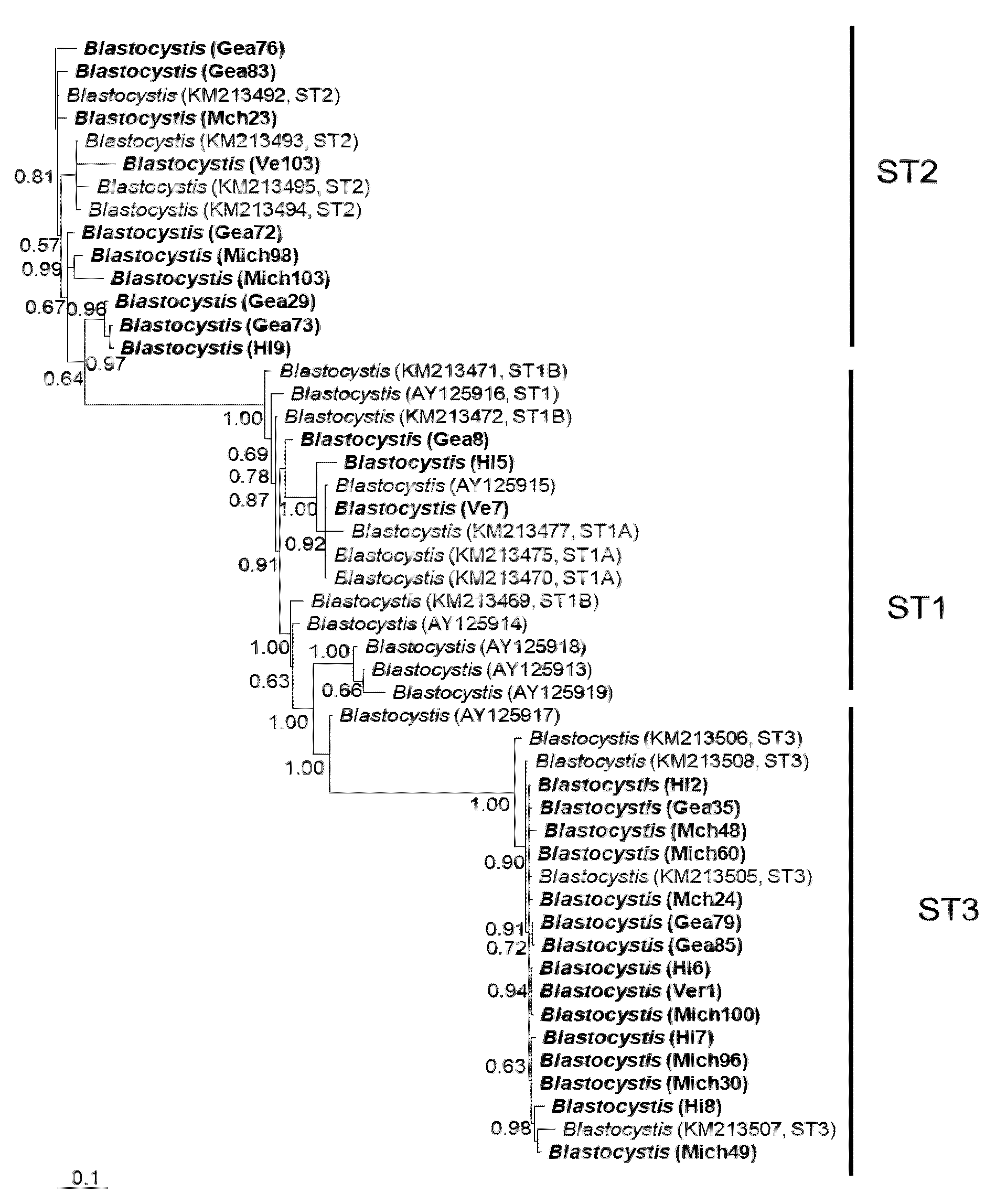

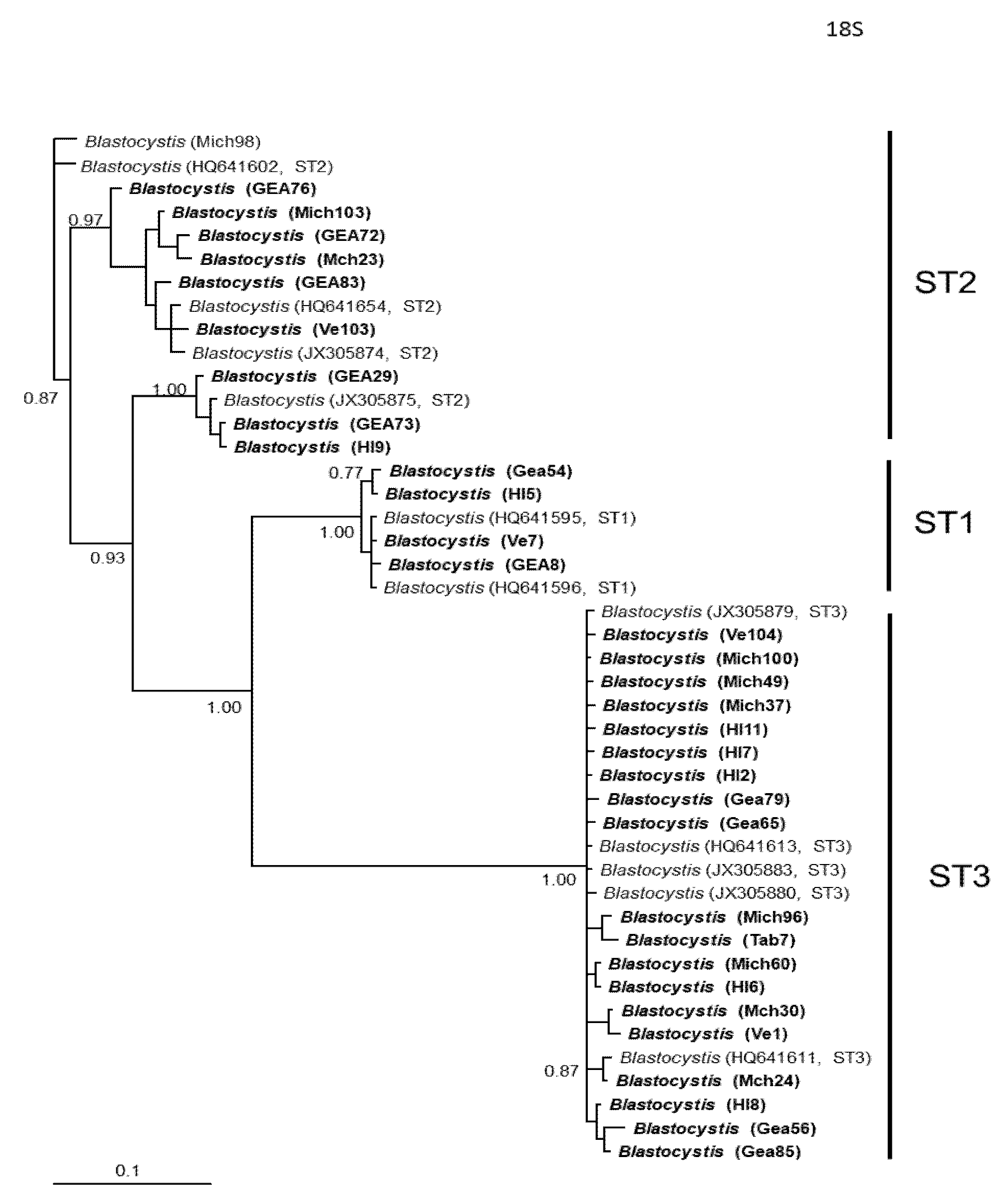
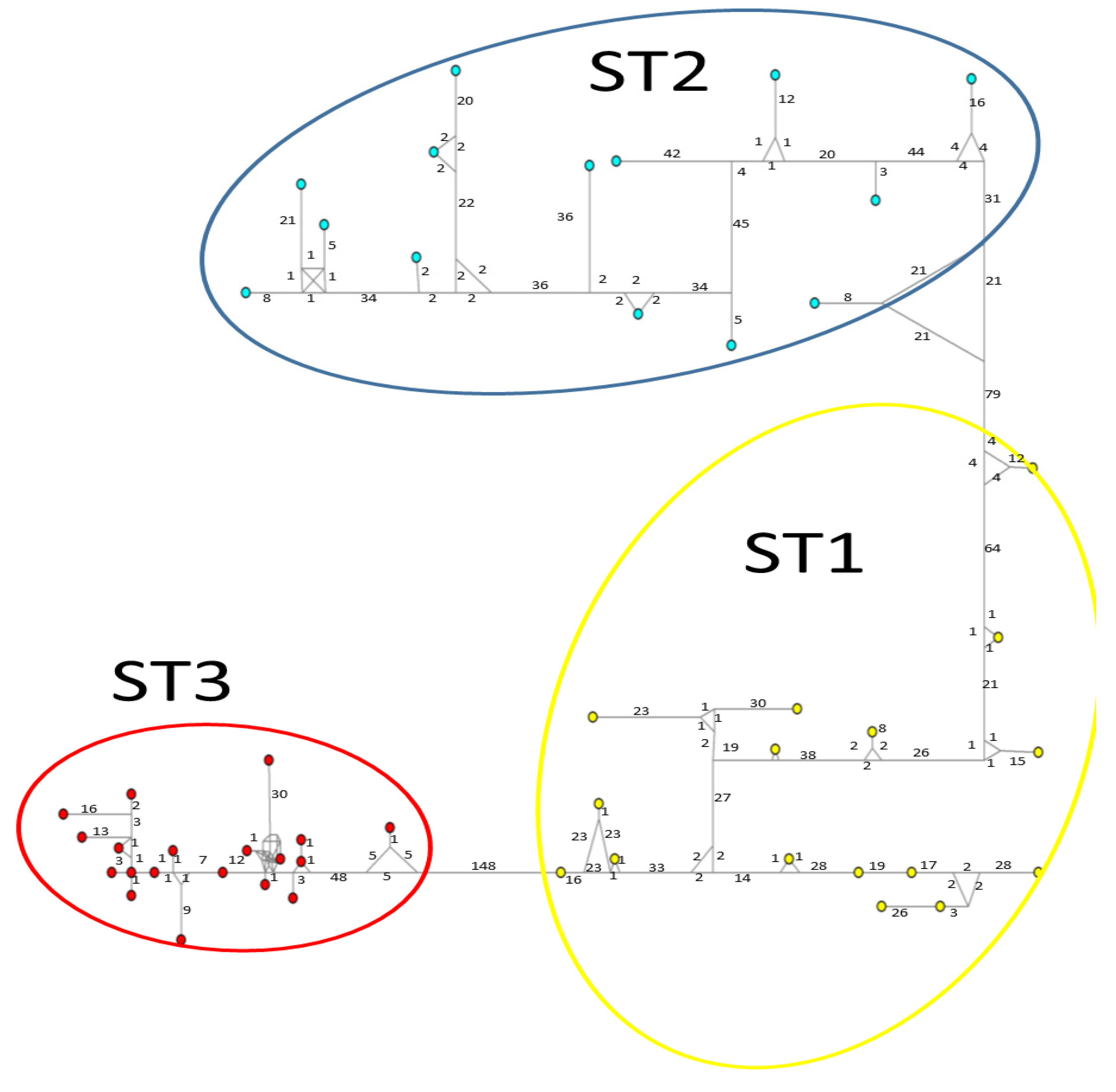
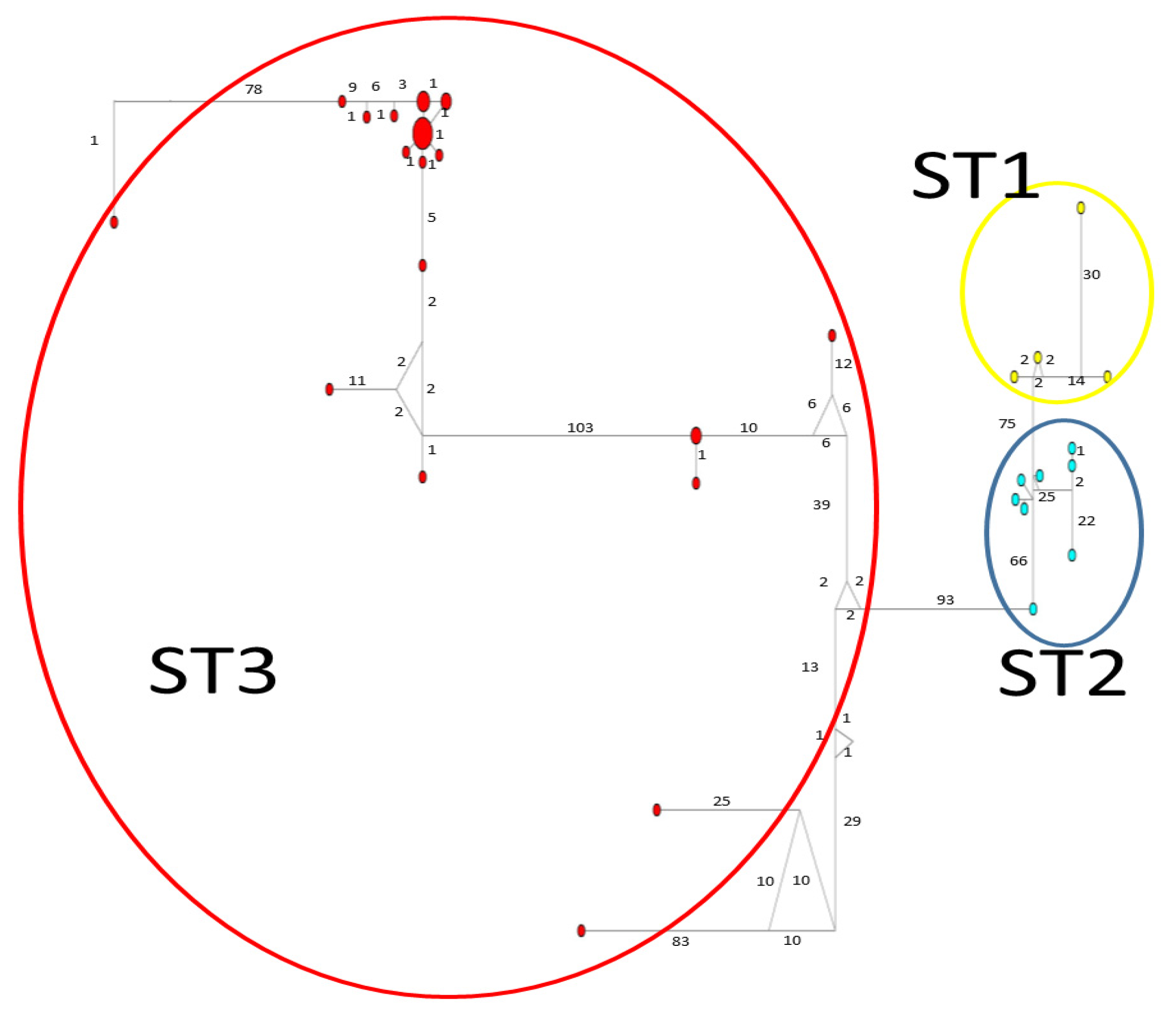
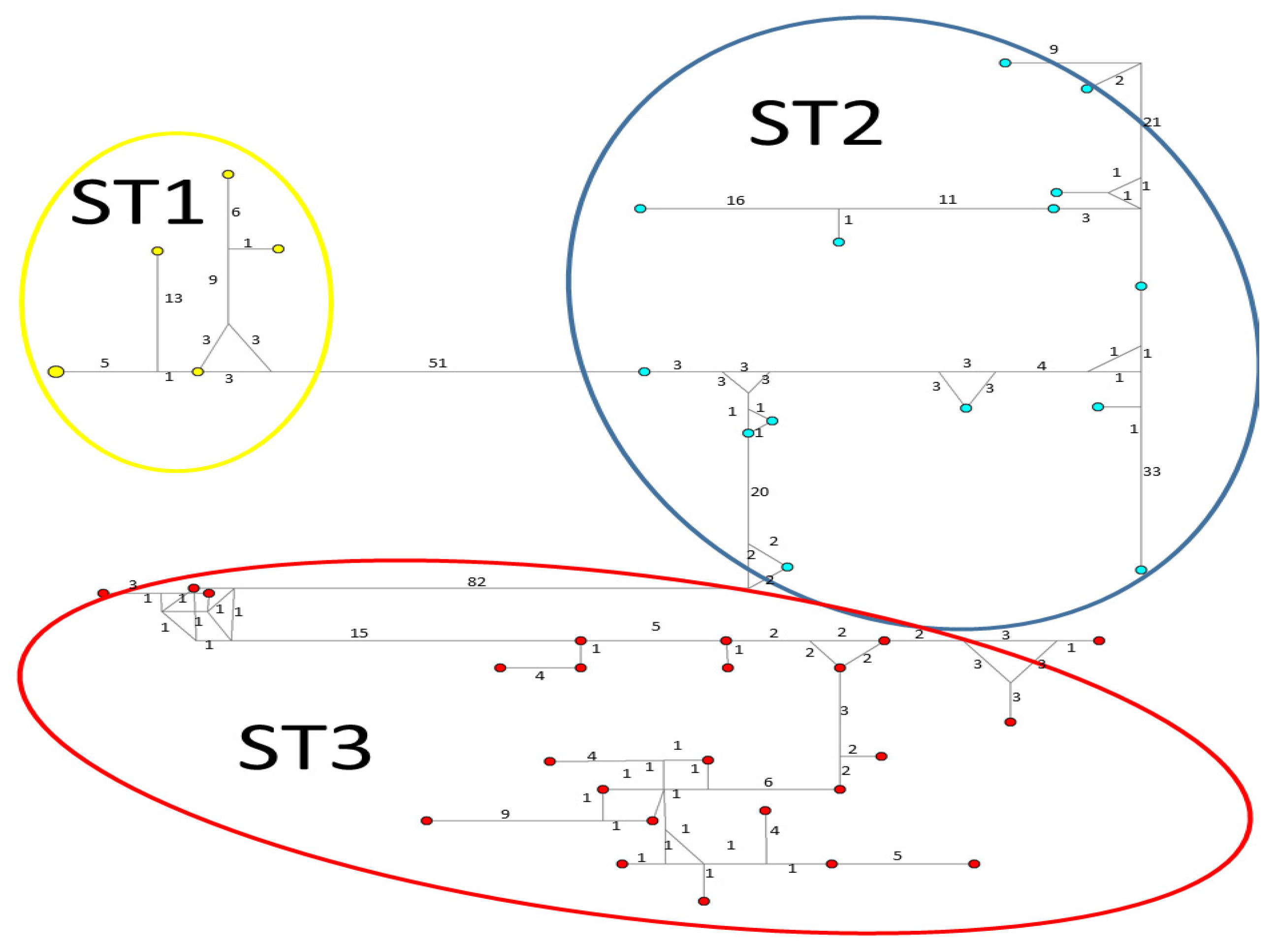

| No. | Sample | Subtype (GenBank Accession Number) | ||
|---|---|---|---|---|
| ITS | SSUrDNA | rpl2 | ||
| 1 | GEA 8 | 1 (PP592306) | 1 (PP587181) | 1 (PP597305) |
| 2 | GEA 29 | 2 (PP592329) | 2 (PP587182) | 2 (PP597309) |
| 3 | GEA 35 | 3 (PP592307) | ND | 3 (PP597318) |
| 4 | GEA 54 | ND * | 1 (PP587183) | 1 (PP597308) |
| 5 | GEA 56 | ND | 3 (PP587184) | 3 (PP597319) |
| 6 | GEA 65 | ND | 3 (PP587185) | 3 (PP597320) |
| 7 | GEA 72 | 2 (PP592308) | 2 (PP587186) | 2 (PP597310) |
| 8 | GEA 73 | 2 (PP592309) | 2 (PP587187) | 2 (PP597311) |
| 9 | GEA 76 | 2 (PP592310) | 2 (PP587188) | 2 (PP597312) |
| 10 | GEA 79 | 3 (PP592311) | 3 (PP587189) | 3 (PP597321) |
| 11 | GEA 83 | 2 (PP592312) | 2 (PP587190) | 2 (PP597313) |
| 12 | GEA 85 | 3 (PP592313) | 3 (PP587191) | 3 (PP597322) |
| 13 | HI2 | 3 (PP592314) | 3 (PP587192) | 3 (PP597323) |
| 14 | HI5 | 1 (PP592315) | 1 (PP587193) | 1 (PP597306) |
| 15 | HI6 | 3 (PP592316) | 3 (PP587194) | 3 (PP597326) |
| 16 | HI7 | 3 (PP592317) | 3 (PP587195) | 3 (PP597325) |
| 17 | HI8 | 3 (PP592318) | 3 (PP587196) | 3 (PP597326) |
| 18 | HI9 | 2 (PP592319) | 2 (PP587197) | 2 (PP597314) |
| 19 | HI11 | ND | 3 (PP587198) | 3 (PP597327) |
| 20 | HI 12 | ND | ND | 3 (PP597328) |
| 21 | Mich 23 | 2 (PP592320) | 2 (PP587199) | 2 (PP597315) |
| 22 | Mich 24 | 3 (PP592321) | 3 (PP587200) | 3 (PP597329) |
| 23 | Mich 30 | 3 (PP592322) | 3 (PP587201) | 3 (PP597330) |
| 24 | Mich 37 | ND | 3 (PP587202) | 3 (PP597331) |
| 25 | Mich 48 | 3 (PP592323) | ND | 3 (PP597332) |
| 26 | Mich 49 | 3 (PP592324) | 3 (PP587203) | 3 (PP597333) |
| 27 | Mich 60 | 3 (PP592325) | 3 (PP587204) | 3 (PP597334) |
| 28 | Mich 96 | 3 (PP592326) | 3 (PP587205) | 3 (PP597335) |
| 29 | Mich 98 | 2 (PP592327) | 2 (PP587206) | ND |
| 30 | Mich 100 | 3 (PP592328) | 3 (PP587207) | 3 (PP597336) |
| 31 | Mich 103 | 2 (PP592330) | 2 (PP587208) | 2 (PP597316) |
| 32 | Tab 7 | ND | 3 (PP587209) | 3 (PP597337) |
| 33 | Ve 1 | 3 (PP592331) | 3 (PP587210) | 3 (PP597338) |
| 34 | Ve 7 | 1 (PP592332) | 1 (PP587211) | 1 (PP597307) |
| 35 | Ve 103 | 2 (PP592333) | 2 (PP587212) | 2 (PP597317) |
| 36 | Ve 104 | ND | 3 (PP587213) | 3 (PP597339) |
| Total | 28 | 33 | 35 | |
| Comparison | k Value | p Value |
|---|---|---|
| ITS vs. rpl2 | 1.0 | 1.386 × 10−10 |
| ITS vs. SSUrDNA | 1.0 | 1.966 × 10−10 |
| rpl2 vs. SSUrDNA | 1.0 | 3.371 × 10−12 |
| Loci/ST | n | h | Hd | π | Θ | Tajima’s D | p Value |
|---|---|---|---|---|---|---|---|
| ITS | 28 | 16 | 0.823 | 0.14663 | 0.10865 | ||
| ST1 | 3 | 3 | 1 | 0.05394 | 0.05256 | ND | |
| ST2 | 10 | 9 | 0.978 | 0.05889 | 0.0707 | −1.25023 | p > 0.05 |
| ST3 | 15 | 8 | 0.829 | 0.00608 | 0.00995 | −1.7122 | p > 0.05 |
| SSUrDNA | 33 | 20 | 0.934 | 0.13806 | 0.07457 | ||
| ST1 | 4 | 4 | 1 | 0.00598 | 0.00559 | 0.6501 | p > 0.05 |
| ST2 | 10 | 8 | 0.933 | 0.05737 | 0.03928 | 0.50505 | p > 0.05 |
| ST3 | 19 | 10 | 0.877 | 0.00458 | 0.00511 | −0.96514 | p > 0.05 |
| rpl2 | 35 | 7 | 0.644 | 0.09839 | 0.05845 | ||
| ST1 | 4 | 4 | 1 | 0.00681 | 0.00743 | −0.81734 | p > 0.05 |
| ST2 | 9 | 3 | 0.556 | 0.01222 | 11,107 | 0.38489 | p > 0.05 |
| ST3 | 22 | 8 | 0.545 | 0.00159 | 0.00481 | −2.1949 | p < 0.05 |
Disclaimer/Publisher’s Note: The statements, opinions and data contained in all publications are solely those of the individual author(s) and contributor(s) and not of MDPI and/or the editor(s). MDPI and/or the editor(s) disclaim responsibility for any injury to people or property resulting from any ideas, methods, instructions or products referred to in the content. |
© 2024 by the authors. Licensee MDPI, Basel, Switzerland. This article is an open access article distributed under the terms and conditions of the Creative Commons Attribution (CC BY) license (https://creativecommons.org/licenses/by/4.0/).
Share and Cite
Villalobos, G.; Lopez-Escamilla, E.; Olivo-Diaz, A.; Romero-Valdovinos, M.; Martinez, A.; Maravilla, P.; Martinez-Hernandez, F. Genetic Variation among the Partial Gene Sequences of the Ribosomal Protein Large-Two, the Internal Transcribed Spacer, and the Small Ribosomal Subunit of Blastocystis sp. from Human Fecal Samples. Microorganisms 2024, 12, 1152. https://doi.org/10.3390/microorganisms12061152
Villalobos G, Lopez-Escamilla E, Olivo-Diaz A, Romero-Valdovinos M, Martinez A, Maravilla P, Martinez-Hernandez F. Genetic Variation among the Partial Gene Sequences of the Ribosomal Protein Large-Two, the Internal Transcribed Spacer, and the Small Ribosomal Subunit of Blastocystis sp. from Human Fecal Samples. Microorganisms. 2024; 12(6):1152. https://doi.org/10.3390/microorganisms12061152
Chicago/Turabian StyleVillalobos, Guiehdani, Eduardo Lopez-Escamilla, Angelica Olivo-Diaz, Mirza Romero-Valdovinos, Arony Martinez, Pablo Maravilla, and Fernando Martinez-Hernandez. 2024. "Genetic Variation among the Partial Gene Sequences of the Ribosomal Protein Large-Two, the Internal Transcribed Spacer, and the Small Ribosomal Subunit of Blastocystis sp. from Human Fecal Samples" Microorganisms 12, no. 6: 1152. https://doi.org/10.3390/microorganisms12061152






